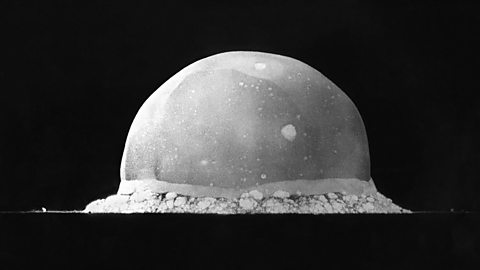The Potsdam Conference, July 1945
The next meeting of the Big Three took place in August 1945 at Potsdam, just outside Berlin.
The main objective of the Potsdam Conference was to finalise a post-war settlement and put into action all the things agreed at Yalta.
While the meeting at Yalta had been reasonably friendly, the Potsdam Conference was fraught with disagreements, which were the result of some significant changes that had taken place since the Yalta Conference.
A new US President
The US President, Franklin D Roosevelt, had died and been replaced by his Vice-President, Harry S Truman. Roosevelt had believed that co-operation with Stalin was essential, not only because he needed the USSRUnion of Soviet Socialist Republics - collection of states, also known as the Soviet Union. to join the war against Japan, but also because he wanted the Soviet Union to be part of the new United NationsThe successor to the League of Nations, the United Nations was established in 1945 as an international organisation designed to keep peace, uphold international law and set standards in human rights. organisation.
However, Truman was not so keen to work with Stalin. Truman made little secret of his dislike for communismA classless society where all property is owned publicly. and for Stalin personally. He quickly ended the economic support that the Americans had been giving the Soviets through the Lend-LeaseA scheme run by the USA to help Allied nations which were short of money and resources during the Second World War. during the war. Although Truman began the conference with a positive view of Stalin вҖ“ he is believed to have stated I can deal with Stalin
- he became more impatient with the Soviets after the news of the atomic bombA powerful and destructive bomb that gets its power from the energy released when atoms are split. emerged.
Nuclear Threat

Just before the Conference began, on 16 July 1945, the USA had successfully exploded an atomic bomb at their test site in the New Mexico desert. When first told about the success of the experiment, Truman is said to have remarked: if it works ... IвҖҷll sure have a hammer on those boys
. At Potsdam, Truman chose to inform Stalin that the US possessed вҖҳa new weapon of unusual destructive forceвҖҷ.
Expansion of Communism
Despite agreeing at Yalta that free elections would be held in Eastern Europe after the defeat of Nazi GermanyNazi Germany is a common name of a period of history in Germany between 1933 to 1945, under the control of Adolf Hitler and the Nazi Party., there was little evidence at Potsdam that Stalin intended to allow them. In fact the Red ArmyArmy of the USSR. was in control of Poland where the USSR was in the process of setting up a communismA classless society where all property is owned publicly. government.
Outcome
Little real progress was made at Potsdam beyond an agreement to put into action the commitments made at Yalta.
Revision recap
The main points of the two Conferences are summarised in the table below. You can use the acronym PEER вҖ“ People, Elections, Europe, Reparations to remember the main points.
| Yalta | Potsdam | |
| People | Participants: Churchill, Roosevelt and Stalin | Participants: Atlee (who replaced Churchill midway), Truman and Stalin |
| Europe | Germany to be divided into four zones of occupation - Berlin to also be divided | Arguments over where the boundaries between the zones would be drawn |
| Elections | Stalin to have a вҖҳsphere of influenceвҖҷ over Eastern Europe but all countries freed from Nazi occupation would be allowed free elections to choose their own governments | There was no sign of Stalin allowing free elections in Eastern Europe and a communist government was being set up in Poland |
| Reparations | The USSR would be allowed to take reparations from defeated Germany | Arguments about how much the USSR should be allowed to take in reparations. It was agreed that the Soviets could take whatever they wanted from the Soviet controlled zone and 10 per cent from the Western zones. This remained a source of disagreement, with the Western Allies worried that they were repeating the mistakes of the Treaty of Versailles after World War One |
| People | |
|---|---|
| Yalta | Participants: Churchill, Roosevelt and Stalin |
| Potsdam | Participants: Atlee (who replaced Churchill midway), Truman and Stalin |
| Europe | |
|---|---|
| Yalta | Germany to be divided into four zones of occupation - Berlin to also be divided |
| Potsdam | Arguments over where the boundaries between the zones would be drawn |
| Elections | |
|---|---|
| Yalta | Stalin to have a вҖҳsphere of influenceвҖҷ over Eastern Europe but all countries freed from Nazi occupation would be allowed free elections to choose their own governments |
| Potsdam | There was no sign of Stalin allowing free elections in Eastern Europe and a communist government was being set up in Poland |
| Reparations | |
|---|---|
| Yalta | The USSR would be allowed to take reparations from defeated Germany |
| Potsdam | Arguments about how much the USSR should be allowed to take in reparations. It was agreed that the Soviets could take whatever they wanted from the Soviet controlled zone and 10 per cent from the Western zones. This remained a source of disagreement, with the Western Allies worried that they were repeating the mistakes of the Treaty of Versailles after World War One |
- List the Big Three at the Potsdam conference and what each oneвҖҷs main priority was.
- Explain how the Big Three needed each other to fulfil their priorities.
- Explain how the priorities of the Big Three might have been difficult to fulfil at the same time.
- Consider TWO big differences about the way that the Grand Alliance worked at Yalta and how it worked at Potsdam.